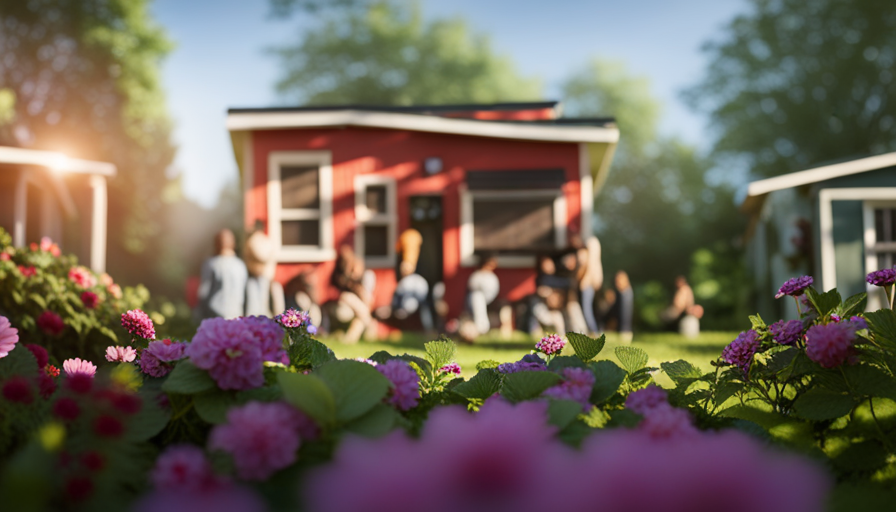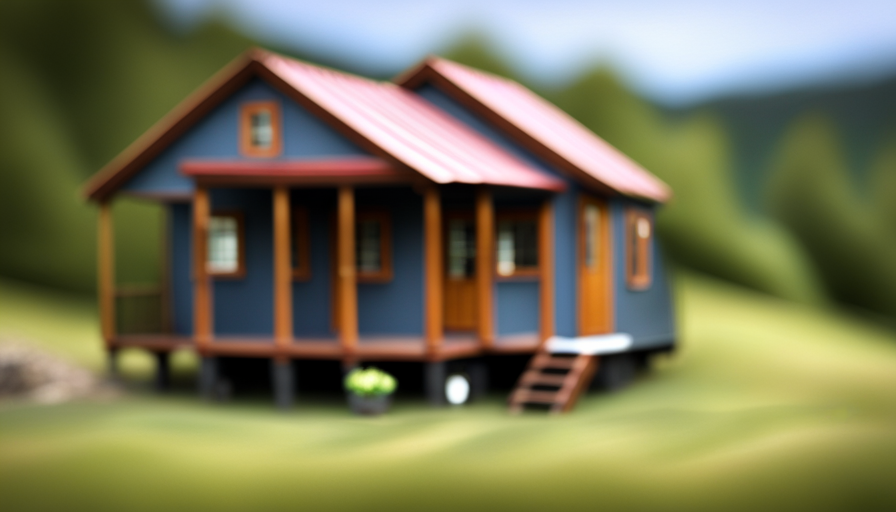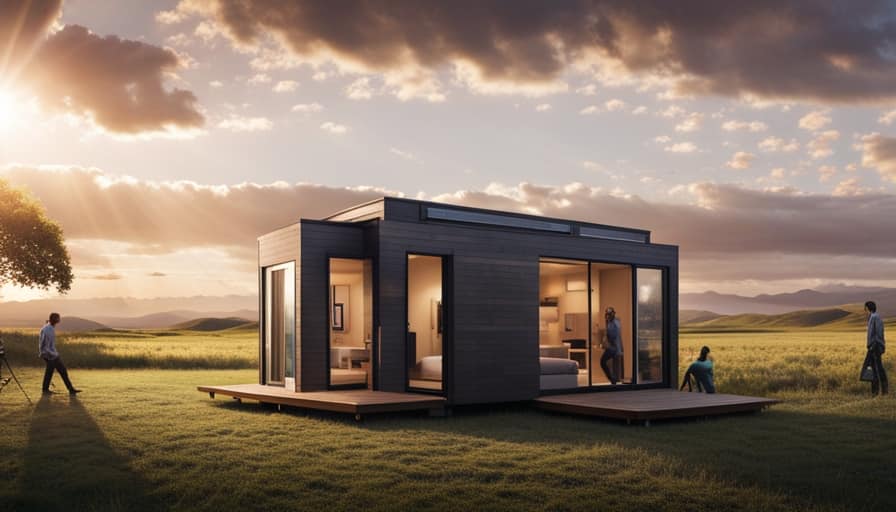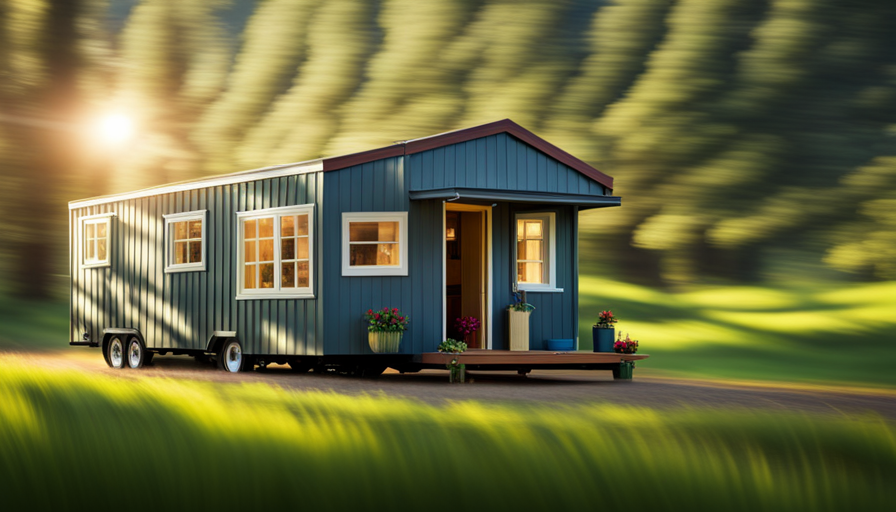In the world of tiny houses in California, the saying that ‘good things come in small packages’ is truly fitting. Tiny houses have become a hugely popular housing trend, offering a unique and efficient living option for those embracing a minimalist lifestyle.
But just how big can a tiny house be in the Golden State? In this article, we will delve into the regulations and permits that govern the size of tiny houses in California, as well as the challenges faced by their owners. Additionally, we will explore creative design solutions for maximizing space within these diminutive dwellings and the rise of community living and tiny house villages across the state.
Lastly, we will discuss the environmental benefits of tiny houses and the future of this innovative housing movement in California. So, let’s dive in and discover the boundless possibilities of living big in a tiny house in the land of sunshine and dreams.
Key Takeaways
- Tiny houses in California are defined as dwelling units that are no more than 400 square feet in size according to the California Health and Safety Code.
- Zoning regulations and minimum square footage requirements vary across cities and counties in California, so it’s important to research and understand specific requirements before building a tiny house.
- Building codes must be followed when constructing a tiny house, including safety, plumbing, electrical, and structural requirements.
- Some areas in California allow tiny houses on wheels as long as they are classified as recreational vehicles, but obtaining permits can still be a complex process involving inspections, fees, and compliance with local regulations.
Understanding the Definition of a Tiny House in California
Do you ever wonder how much space you can actually have in a tiny house in California?
When it comes to defining tiny houses in California, there are some legal requirements that need to be considered. According to the California Health and Safety Code, a tiny house is defined as a dwelling unit that is no more than 400 square feet in size. This includes both the main living area and any additional loft spaces. Additionally, the tiny house must include basic facilities such as a kitchen, bathroom, and sleeping area. These legal requirements ensure that tiny houses meet certain standards for safe and comfortable living.
Moving on to zoning regulations and permits for tiny houses…
Zoning Regulations and Permits for Tiny Houses
Zoning regulations and permits often dictate the maximum size a small dwelling can be in the beautiful state of California. These regulations ensure that tiny houses meet certain standards and are compatible with existing neighborhoods. Here are five key things to know about zoning regulations and permits for tiny houses in California:
-
Zoning regulations vary across different cities and counties, so it’s important to research and understand the specific requirements in your area.
-
Some areas have minimum square footage requirements, which means your tiny house must meet a certain size threshold to be considered a legal dwelling.
-
Building codes must be followed when constructing a tiny house, including requirements for safety, plumbing, electrical, and structural elements.
-
Some areas allow tiny houses on wheels as long as they are classified as recreational vehicles and not permanent dwellings.
-
Obtaining permits for a tiny house can be a complex process, involving inspections, fees, and compliance with local regulations.
These zoning regulations and permitting processes can present challenges for tiny house owners in California, which we will explore in the next section.
Challenges Faced by Tiny House Owners in California
Navigating the complex landscape of regulations and permits can pose significant obstacles for aspiring tiny house owners in the Golden State. Zoning challenges are a major concern for those looking to establish a tiny house in California. Many cities have strict zoning regulations that limit the placement of tiny houses, often requiring them to be located in designated zones or as accessory dwelling units. This can make finding suitable land a difficult task, especially in densely populated areas.
Additionally, financial obstacles can also hinder the dreams of tiny house ownership. The cost of land, permits, and construction materials can add up quickly, making it challenging for individuals with limited resources to pursue their tiny house dreams.
Despite these challenges, many creative design solutions exist for maximizing space in tiny houses, allowing owners to make the most of their limited square footage without sacrificing comfort or functionality.
Creative Design Solutions for Maximizing Space in Tiny Houses
Finding innovative design solutions allows tiny house owners to optimize the use of space, enabling them to fully utilize the limited square footage while ensuring comfort and functionality.
One effective way to maximize space in a tiny house is by incorporating space-saving furniture. This includes multi-purpose furniture such as foldable tables and chairs, sofa beds, and wall-mounted desks. These furniture pieces can be easily transformed or tucked away when not in use, freeing up valuable floor space.
Additionally, creative storage solutions are crucial in tiny houses. Utilizing vertical space with tall cabinets and shelves, using under-bed storage, and installing built-in storage units can help keep belongings organized and out of sight. These solutions not only create a clutter-free living environment but also make the most of every inch.
Transitioning into the next section, community living and tiny house villages in California offer additional opportunities for tiny house owners to maximize their living experience.
Community Living and Tiny House Villages in California
Living in close-knit communities and tiny house villages in the state of California offers tiny house owners the opportunity to enhance their living experience and explore the potential benefits of communal living. Community engagement is a key aspect of this lifestyle, as it fosters a sense of belonging and support among residents. Tiny house villages provide a unique platform for individuals to connect with like-minded individuals who share a passion for sustainable living and minimalistic lifestyles. These communities often organize events, workshops, and social gatherings, promoting a strong sense of community and friendship. In addition to the social benefits, tiny house villages also offer affordability options, allowing individuals to live in a desirable location without the burden of high housing costs. Transitioning to the subsequent section, exploring the environmental benefits of tiny houses in California highlights another compelling aspect of this movement.
Environmental Benefits of Tiny Houses in California
When it comes to tiny houses in California, there are several environmental benefits that can’t be ignored. Firstly, these homes have a significantly reduced carbon footprint compared to traditional houses, as they require less energy for heating, cooling, and lighting.
Additionally, tiny houses often incorporate energy efficiency and sustainability features such as solar panels and rainwater harvesting systems, further minimizing their impact on the environment.
Lastly, living in a tiny house promotes a minimalist and eco-conscious lifestyle, encouraging individuals to reduce their consumption and live more sustainably.
Reduced carbon footprint
By utilizing sustainable materials and energy-efficient systems, a tiny house in California can significantly reduce its carbon footprint, making it an eco-friendly and environmentally conscious living option.
Renewable energy sources such as solar panels can be installed on the roof of the tiny house to generate electricity. This not only reduces the dependency on traditional energy sources but also decreases the emission of greenhouse gases.
Additionally, sustainable materials such as reclaimed wood and recycled insulation can be used in the construction of the tiny house, further minimizing the environmental impact. Energy-efficient systems like LED lighting and low-flow plumbing fixtures also contribute to reducing energy consumption and water usage.
These features help create a sustainable living environment that promotes conservation and minimizes waste. Transitioning into the subsequent section, energy efficiency and sustainability features play a crucial role in making a tiny house in California environmentally friendly.
Energy efficiency and sustainability features
Using sustainable materials and energy-efficient systems, a tiny home can significantly decrease its carbon footprint and create an eco-friendly living space. Energy efficient building materials, such as insulation made from recycled materials and low-emissivity windows, help to reduce energy consumption and maintain a comfortable indoor temperature. Additionally, incorporating renewable energy systems like solar panels and rainwater harvesting can further enhance the sustainability of a tiny home. These systems allow homeowners to generate their own electricity and collect and reuse water, reducing reliance on traditional energy sources and minimizing waste. By implementing these energy efficiency and sustainability features, tiny homes in California can not only reduce their environmental impact but also promote a minimalist and eco-conscious lifestyle. The next section will explore how tiny homes can inspire individuals to live more sustainably.
Promoting a minimalist and eco-conscious lifestyle
Embracing a minimalist and eco-conscious lifestyle can lead to a significant reduction in waste and a more sustainable future. Studies show that individuals who adopt this approach can decrease their carbon footprint by up to 50%.
When it comes to tiny house living in California, promoting a minimalist and eco-conscious lifestyle goes hand in hand with the concept of tiny homes. Here are four ways in which this lifestyle can be achieved:
-
Minimalist Home Decor: By focusing on simplicity and functionality, minimalist home decor allows for a clutter-free living space, reducing the need for excess furniture and decorations.
-
Sustainable Building Materials: Using eco-friendly materials such as reclaimed wood, recycled metal, and natural fibers not only reduces environmental impact but also creates a healthier living environment.
-
Energy-efficient Appliances: Opting for energy-efficient appliances can significantly reduce energy consumption and lower utility bills.
-
Water Conservation: Implementing water-saving features like low-flow fixtures and rainwater harvesting systems can help conserve this precious resource.
By embracing these principles, we can pave the way for a more sustainable and mindful future. As we look ahead to the future of tiny house living in California, it’s clear that the minimalist and eco-conscious approach will continue to play a crucial role in shaping this movement.
The Future of Tiny House Living in California
In discussing the future of tiny house living in California, it’s important to consider the advocacy and policy changes that are driving this movement forward.
There is a growing acceptance and support from local governments. They are recognizing the benefits of tiny houses in addressing housing affordability and sustainability issues.
Additionally, trends and innovations in the tiny house movement continue to emerge. New designs and technologies are pushing the boundaries of what’s possible in this alternative form of housing.
Advocacy and policy changes
Advocates and policy changes have made it possible for tiny houses in California to be bigger than ever before. Thanks to the efforts of advocacy initiatives, the legal implications surrounding tiny house living have become more favorable. These changes have opened up new possibilities for individuals looking to embrace the tiny house lifestyle.
To further understand the impact of these changes, let’s take a look at a comparison table showcasing the size restrictions for tiny houses before and after the policy changes:
| Size Restrictions Before | Size Restrictions After |
|---|---|
| Maximum 400 square feet | Maximum 600 square feet |
| Height limit of 13.5 feet | Height limit of 15 feet |
| Minimum lot size of 5,000 square feet | No minimum lot size |
As you can see, the new policy changes have allowed for larger tiny houses and have eliminated the minimum lot size requirement. This has undoubtedly contributed to the growing acceptance and support from local governments. The subsequent section will delve into this topic further.
Growing acceptance and support from local governments
With the recent policy changes, local governments have started to warmly embrace the idea of larger, more affordable housing options in their communities. This growing acceptance and support from local governments is a significant milestone for the tiny house movement in California.
Many local governments are recognizing the benefits of tiny houses, such as their lower environmental impact and the potential to address the housing crisis. To accommodate this new trend, some local governments have revised their building codes to allow for larger tiny houses, providing more livable space for residents.
This shift in local government support has created exciting opportunities for individuals and families looking to downsize or find more affordable housing options. As the tiny house movement continues to gain momentum, it will be interesting to explore the trends and innovations that are shaping this rapidly evolving movement.
Trends and innovations in the tiny house movement
As local governments continue to embrace the tiny house movement, it’s fascinating to see the trends and innovations that are emerging within this unique housing niche.
One of the most exciting developments is the focus on trendy interior designs in tiny houses. Designers are finding creative ways to maximize space without sacrificing style, using sleek finishes, modern furniture, and clever layouts that make these tiny homes feel luxurious and inviting. From minimalist and Scandinavian-inspired designs to bold and eclectic aesthetics, there is a wide range of options to suit different tastes and preferences.
Additionally, innovative storage solutions have become a key feature in tiny houses. From hidden compartments and built-in shelving to multipurpose furniture that serves dual functions, these solutions are revolutionizing the way we think about storage in small spaces.
The tiny house movement is not only changing the way we live, but also inspiring new design ideas and pushing the boundaries of what is possible in a limited space.
Frequently Asked Questions
What is the maximum square footage allowed for a tiny house in California?
The maximum square footage allowed for a tiny house in California is determined by local building codes. These codes vary depending on the jurisdiction, but typically range from 150 to 400 square feet.
It’s important to note that building codes may also include requirements for height, foundation type, and other structural considerations. Therefore, it’s crucial to research and consult with local authorities before constructing a tiny house to ensure compliance with the maximum square footage allowed.
Are there any specific building codes that apply to tiny houses in California?
Building code requirements and zoning regulations in California do apply to tiny houses. Specific guidelines have been established to ensure the safety and livability of these compact dwellings. These codes address various aspects, such as minimum ceiling height, stair dimensions, and plumbing requirements.
Additionally, zoning regulations dictate where tiny houses can be placed, often requiring them to be on a permanent foundation or in designated areas. Compliance with these regulations is crucial for legal construction and habitation.
How do tiny house owners in California deal with utility connections and infrastructure?
When it comes to utility connections and infrastructure, tiny house owners in California often opt for off-grid living and alternative energy sources. Many choose to install solar panels to power their homes and utilize rainwater collection systems for their water needs. Composting toilets are also popular among tiny house owners as a sustainable alternative. These choices allow them to be self-sufficient and reduce their reliance on traditional utility connections, making their tiny house living experience more sustainable and environmentally friendly.
Are there any restrictions on parking or placement of tiny houses in California?
When it comes to parking or placement of tiny houses in California, there are indeed some restrictions to keep in mind. Zoning regulations dictate where these compact dwellings can be parked or placed. It’s crucial to research and adhere to local zoning laws to avoid any legal issues.
Additionally, parking restrictions may vary depending on the specific area. Therefore, it’s essential to check with local authorities or consult a professional to ensure compliance with all regulations.
What are the potential financial benefits of living in a tiny house in California compared to traditional housing options?
Living in a tiny house in California can bring significant financial benefits compared to traditional housing options. Firstly, property taxes for tiny houses are generally much lower due to their smaller size.
Additionally, tiny houses are often more environmentally sustainable, resulting in lower utility costs.
Furthermore, their compact design requires less maintenance and fewer materials, saving both time and money.
Overall, choosing a tiny house in California can provide financial advantages while promoting environmental sustainability.
Conclusion
In conclusion, the tiny house movement in California is growing, despite the challenges faced by homeowners. Zoning regulations and permits can be complex, but with determination and creativity, individuals can find solutions to maximize space and create functional living areas.
For example, I spoke with Sarah, a tiny house owner in San Francisco, who transformed her 300-square-foot home into a multi-functional space using innovative design techniques. Her tiny house serves as a home office during the day and transforms into a cozy living space in the evening, showcasing the versatility and potential of tiny houses.
As the environmental benefits of tiny houses become more apparent, and as communities continue to embrace the concept, the future of tiny house living in California looks promising.
Hi, I’m Emma. I’m the Editor in Chief of Tiny House 43, a blog all about tiny houses. While tree houses are often associated with childhood, they can be the perfect adult retreat. They offer a cozy space to relax and unwind, surrounded by nature. And since they’re typically built on stilts or raised platforms, they offer stunning views that traditional homes simply can’t match. If you’re looking for a unique and romantic getaway, a tree house tiny house might just be the perfect option.










